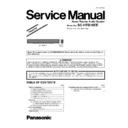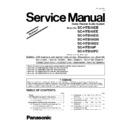Panasonic SC-HTB10EE Simplified Service Manual ▷ View online
PSG1006002AE
Home Theater Audio System
Model No.
SC-HTB10EE
Product Color : (K)... Black Type
TABLE OF CONTENTS
PAGE
PAGE
1 Safety Precautions----------------------------------------------- 2
1.1. General Guidelines---------------------------------------- 2
1.2. Before Repair and Adjustment ------------------------- 3
1.3. Caution For Fuse Replacement------------------------ 3
1.4. Protection Circuitry ---------------------------------------- 3
1.5. Safety Part Information----------------------------------- 3
1.6. Safety Instation Instructions ------------------------- 4
1.2. Before Repair and Adjustment ------------------------- 3
1.3. Caution For Fuse Replacement------------------------ 3
1.4. Protection Circuitry ---------------------------------------- 3
1.5. Safety Part Information----------------------------------- 3
1.6. Safety Instation Instructions ------------------------- 4
2 Warning -------------------------------------------------------------- 5
2.1. Prevention of Electro Static Discharge (ESD)
to Electrostaticy Sensitive (ES) Devices---------- 5
2.2. Service caution based on Legal restrictions -------- 6
3 Service Navigation ----------------------------------------------- 7
3.1. Service Information --------------------------------------- 7
4 Specifications ----------------------------------------------------- 8
5 Exploded View and Replacement Parts List -------------9
5.1. Exploded View and Mechanical Replacement
Parts List -----------------------------------------------------9
Notes: This model is based on SC-HTB10EB/EG-K. Please refer to the original service manual (Order no.
PSG1005027CE).
PSG1005027CE).
2
1 Safety Precautions
1.1.
General Guidelines
1. When servicing, observe the original lead dress. If a short circuit is found, replace all parts which have been overheated or
damaged by the short circuit.
2. After servicing, see to it that all the protective devices such as insulation barriers, insulation papers shields are properly
installed.
3. After servicing, carry out the following leakage current checks to prevent the customer from being exposed to shock hazards.
1.1.1.
Leakage Current Cold Check
1. Unplug the AC cord and connect a jumper between the two prongs on the plug.
2. Measure the resistance value, with an ohmmeter between the jumpered AC plug and each exposed metallic cabinet part on
2. Measure the resistance value, with an ohmmeter between the jumpered AC plug and each exposed metallic cabinet part on
the equipment such as screwheads, connectors, control shafts, etc. When the exposed metallic part has a return path to the
chassis, the reading should be between 1M
chassis, the reading should be between 1M
Ω and 5.2MΩ. When the exposed metal does not have a return path to the chas-
sis, the reading must be
1.1.2.
Leakage Current Hot Check
1. Plug the AC cord directly into the AC outlet. Do not use an isolation transformer for this check.
2. Connect a 1.5k
2. Connect a 1.5k
Ω, 10 watts resistor, in parallel with a 0.15μF capacitors, between each exposed metallic part on the set and a
good earth ground such as a water pipe, as shown in Figure 1.
3. Use an AC voltmeter, with 1000 ohms/volt or more sensitivity, to measure the potential across the resistor.
4. Check each exposed metallic part, and measure the voltage at each point.
5. Reverse the AC plug in the AC outlet and repeat each of the above measurements.
6. The potential at any point should not exceed 0.75 volts RMS. A leakage current tester (Simpson Model 229 or equivalent)
4. Check each exposed metallic part, and measure the voltage at each point.
5. Reverse the AC plug in the AC outlet and repeat each of the above measurements.
6. The potential at any point should not exceed 0.75 volts RMS. A leakage current tester (Simpson Model 229 or equivalent)
may be used to make the hot checks, leakage current must not exceed 1/2 milliamp. In case a measurement is outside of the
limits specified, there is a possibility of a shock hazard, and the equipment should be repaired and rechecked before it is
returned to the customer.
limits specified, there is a possibility of a shock hazard, and the equipment should be repaired and rechecked before it is
returned to the customer.
Figure. 1
3
1.2.
Before Repair and Adjustment
Disconnect AC power, discharge unit AC Capacitors as such C5700, C5701, C5702, C5703, C5704, C5706, C5708 through a 10
Ω,
1W resistor to ground.
DO NOT SHORT-CIRCUIT DIRECTLY (with a screwdriver blade, for instance), as this may destroy solid state devices.
After repairs are completed, restore power gradually using a variac, to avoid overcurrent.
DO NOT SHORT-CIRCUIT DIRECTLY (with a screwdriver blade, for instance), as this may destroy solid state devices.
After repairs are completed, restore power gradually using a variac, to avoid overcurrent.
• Current consumption at AC 220-240 V, at 50 Hz in NO SIGNAL mode, at volume minimum, SEL: HDMI/D-IN should be 600 mA.
1.3.
Caution For Fuse Replacement
1.4.
Protection Circuitry
The protection circuitry may have operated if either of the following conditions are noticed:
• No sound is heard when the power is turned on.
• Sound stops during a performance.
• Sound stops during a performance.
The function of this circuitry is to prevent circuitry damage if, for example, the positive and negative speaker connection wires are
"shorted", or if speaker systems with an impedance less than the indicated rated impedance of the amplifier are used.
If this occurs, follow the procedure outlines below:
"shorted", or if speaker systems with an impedance less than the indicated rated impedance of the amplifier are used.
If this occurs, follow the procedure outlines below:
1. Turn off the power.
2. Determine the cause of the problem and correct it.
3. Turn on the power once again after one minute.
2. Determine the cause of the problem and correct it.
3. Turn on the power once again after one minute.
Note:
When the protection circuitry functions, the unit will not operate unless the power is first turned off and then on again.
When the protection circuitry functions, the unit will not operate unless the power is first turned off and then on again.
1.5.
Safety Part Information
Safety Parts List:
There are special components used in this equipment which are important for safety.
These parts are marked by in the Schematic Diagrams, Exploded View & Replacement Parts List. It is essential that these
critical parts should be replaced with manufacturer’s specified parts to prevent shock, fire or other hazards. Do not modify the
original design without permission of manufacturer.
These parts are marked by in the Schematic Diagrams, Exploded View & Replacement Parts List. It is essential that these
critical parts should be replaced with manufacturer’s specified parts to prevent shock, fire or other hazards. Do not modify the
original design without permission of manufacturer.
Table 1
Safety
Ref. No.
Part No.
Part Name & Description
Remarks
2
REXX1104
1P RED/BLACK WIRE (AC INLET-SMPS)
8
RYPX1070B-K
FRONT PANEL UNIT
9
RYQX1033B-K
BACK CABINET UNIT
17
RGNX1142-K2
SPEC LABEL
A2
RFAX1027B
AC CORD /W FERRITE CODE
A3
RQTX1161-R
O/I BOOK (Ru/Ur)
4
1.6.
Safety Installation Instructions


